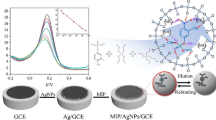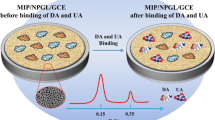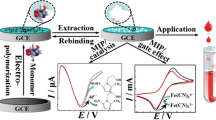Abstract
A novel dual template imprinted matrix developed by the synergistic effect of reduced graphene oxide (rGO) and poly(3-thiophene acetic acid) composite (3-TAA) as imprinting matrix, has been proposed. A molecularly imprinted polymer (MIP) sensor for dual templates, antipyrine, and ethionamide has been prepared by electro polymerization of 3-TAA as a functional monomer on rGO coated glassy carbon electrode (GCE). The objective of this work was to design a dual analyte sensing platform in order to reduce the burden of multiple sensors (needed for each analyte). MIP was characterized by cyclic voltammetry and differential pulse voltammetry (DPV). The designed sensor showed good selectivity towards structural and functional analogous molecules as probable interferants.
Access this chapter
Tax calculation will be finalised at checkout
Purchases are for personal use only
Similar content being viewed by others
References
Whitcombe MJ, Chianella I, Larcombe L et al (2011) The rational development of molecularly imprinted polymer-based sensors for protein detection. Chem Soc Rev 40:1547–1571. https://doi.org/10.1039/c0cs00049c
Chen L, Wang X, Lu W et al (2016) Molecular imprinting: perspectives and applications. Chem Soc Rev 45:2137–2211. https://doi.org/10.1039/C6CS00061D
Sharma PS, Pietrzyk-Le A, D’Souza F, Kutner W (2012) Electrochemically synthesized polymers in molecular imprinting for chemical sensing. Anal Bioanal Chem 402:3177–3204. https://doi.org/10.1007/s00216-011-5696-6
Malitesta C, Guascito MR, Mazzotta E, Picca RA (2010) X-Ray photoelectron spectroscopy characterization of electrosynthesized poly(3-thiophene acetic acid) and its application in molecularly imprinted polymers for atrazine. Thin Solid Films 518:3705–3709. https://doi.org/10.1016/j.tsf.2009.10.016
Janáky C, Endrodi B, Kovács K et al (2010) Chemical synthesis of poly(3-thiophene-acetic-acid)/magnetite nanocomposites with tunable magnetic behaviour. Synth Met 160:65–71. https://doi.org/10.1016/j.synthmet.2009.09.034
Mukherjee P, Dawn A, Nandi AK (2010) Biomolecular hybrid of poly(3-thiophene acetic acid) and double stranded DNA: optical and conductivity properties. Langmuir 26:11025–11034. https://doi.org/10.1021/la101215v
Yang S (2019) Electrochemical sensor based on molecularly imprinted polymer-aptamer hybrid receptor for voltammetric detection of thrombin. 166(2):B23–B28. https://doi.org/10.1149/2.0131902jes
Kim H, Abdala AA, MacOsko CW (2010) Graphene/polymer nanocomposites. Macromolecules 43:6515–6530. https://doi.org/10.1021/ma100572e
Stauber T, Beltrán JI, Schliemann J (2016) Tight-binding approach to pentagraphene. Sci Rep 6:4–11. https://doi.org/10.1038/srep22672
Artiles MS, Rout CS, Fisher TS (2011) Graphene-based hybrid materials and devices for biosensing. Adv Drug Deliv Rev 63:1352–1360. https://doi.org/10.1016/j.addr.2011.07.005
Singh V, Joung D, Zhai L et al (2011) Graphene based materials: past, present and future. Prog Mater Sci 56:1178–1271. https://doi.org/10.1016/j.pmatsci.2011.03.003
Duan D, Yang H, Ding Y et al (2018) Three-dimensional molecularly imprinted electrochemical sensor based on Au NPs@Ti-based metal-organic frameworks for ultra-trace detection of bovine serum albumin. Electrochim Acta 261:160–166. https://doi.org/10.1016/j.electacta.2017.12.146
Taniselass S, Arshad MKM, Gopinath SCB (2019) Graphene-based electrochemical biosensors for monitoring noncommunicable disease biomarkers. Biosens Bioelectron 130:276–292. https://doi.org/10.1016/j.bios.2019.01.047
Zhang H, Gai P, Cheng R et al (2013) Self-assembly synthesis of a hierarchical structure using hollow nitrogen-doped carbon spheres as spacers to separate the reduced graphene oxide for simultaneous electrochemical determination of ascorbic acid, dopamine and uric acid. Anal Methods 5:3591–3600. https://doi.org/10.1039/c3ay40572a
Zou YX, Feng X, Chu ZY et al (2019) Preclinical safety assessment of antipyrine combined with lidocaine hydrochloride as ear drops. Regul Toxicol Pharmacol 103:34–40. https://doi.org/10.1016/j.yrtph.2019.01.018
Vesell ES (1979) The antipyrine test in clinical pharmacology: conceptions and misconceptions. Clin Pharmacol Ther 26:275–286. https://doi.org/10.1002/cpt1979263275
Arbex M, Castro Lima Varella M, Siquera H, Mello F (2010) Antituberculosis drugs: Drug interactions, adverse effects, and use in special situations.J Bras Pneumol 36:626–640. https://doi.org/10.1590/s1806-37132010000500016
Hrichi H, Louhaichi MR, Monser L, Adhoum N (2014) Gliclazide voltammetric sensor based on electropolymerized molecularly imprinted polypyrrole film onto glassy carbon electrode. Sens Actuators B Chem 204:42–49. https://doi.org/10.1016/j.snb.2014.07.056
da Silva H, Pacheco JG, MCS Magalhães J, Viswanathan S, Delerue-Matos C (2014) MIP-graphene-modified glassy carbon electrode for the determination of trimethoprim. Biosens Bioelectron 52:56–61. https://doi.org/10.1016/j.bios.2013.08.035
Srivastava J, Gupta N, Kushwaha A, Umrao S, Srivastava A, Singh M (2019) Highly sensitive and selective estimation of aspartame by chitosan nanoparticle—graphene nanocomposite tailored EQCM-MIP sensor. Polym Bull 76:4431–4449. https://doi.org/10.1007/s00289-018-2597-2
Author information
Authors and Affiliations
Corresponding author
Editor information
Editors and Affiliations
Rights and permissions
Copyright information
© 2022 The Author(s), under exclusive license to Springer Nature Singapore Pte Ltd.
About this paper
Cite this paper
Singh, R., Harijan, M., Singh, M. (2022). Design of Imprinting Matrix for Dual Template Sensing Based on Molecularly Imprinted Polymer Technology. In: Mudali, U.K., Aruna, S.T., Nagaswarupa, H.P., Rangappa, D. (eds) Recent Trends in Electrochemical Science and Technology. Springer Proceedings in Materials, vol 15. Springer, Singapore. https://doi.org/10.1007/978-981-16-7554-6_12
Download citation
DOI: https://doi.org/10.1007/978-981-16-7554-6_12
Published:
Publisher Name: Springer, Singapore
Print ISBN: 978-981-16-7553-9
Online ISBN: 978-981-16-7554-6
eBook Packages: Chemistry and Materials ScienceChemistry and Material Science (R0)




